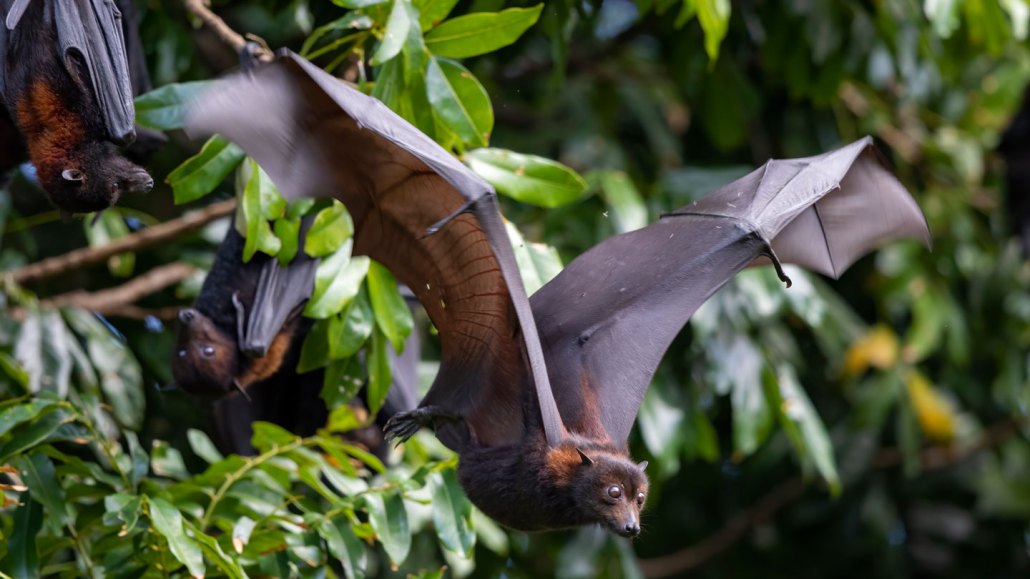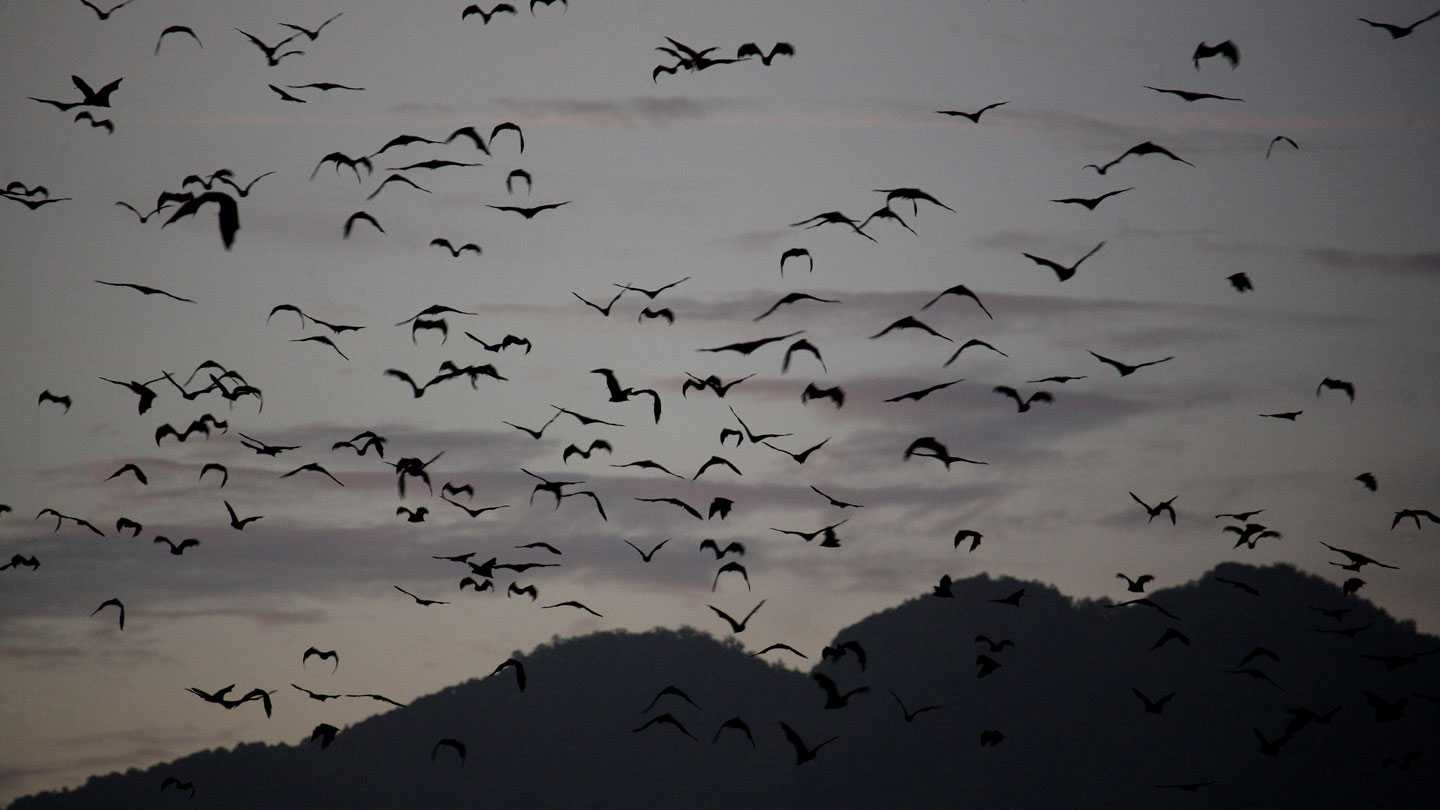Protecting forests may help head off future pandemics
A bat-transmitted virus only spills over to other species when bats can’t find enough food

This bat — a black flying fox — takes flight in an urban roost in Queensland, Australia. This species is most likely to spread Hendra virus to horses.
Pat Jones
Share this:
- Share via email (Opens in new window) Email
- Click to share on Facebook (Opens in new window) Facebook
- Click to share on X (Opens in new window) X
- Click to share on Pinterest (Opens in new window) Pinterest
- Click to share on Reddit (Opens in new window) Reddit
- Share to Google Classroom (Opens in new window) Google Classroom
- Click to print (Opens in new window) Print
COVID-19 is just one example of a disease that has jumped from a wild animal to people. In hopes of preventing future outbreaks, scientists are working to understand what led to the jump, also known as a spillover event. A group working in Australia thinks it may have one answer: Keep wildlife well-fed.
The team shared its findings in a pair of papers in January.
All animals carry germs. Some viruses don’t harm the animals in which they are typically found. That’s because the host species has encountered this virus so often that its immune system has evolved a way to keep the germ in check. But if this virus later finds its way into a new species, it may trigger serious disease.
“It’s helpful to be able to understand why, when and where viruses can pass, or spill over, from wildlife species to humans or other animals,” says Alison Peel. She’s an ecologist at Griffith University in Brisbane, Australia. Peel specializes in wildlife diseases. It’s not easy to track when viruses jump from their wild host to a new one, she says. But doing so can reveal the conditions that allow spillovers to happen.
Peel studies Hendra virus in Australia, which often is found in fruit-eating bats called flying foxes. This virus sometimes spills over into horses. In three out of four such cases, the horse will die. The virus also can jump from horses to people, where it’s deadly more than half the time. Peel is part of a team that wanted to understand what causes the virus to spill over, so they might help prevent future outbreaks.

Tracking a killer virus
From 1996 to 2020, Peel and her group tracked where bats spent their time. The team also noted features of the sites at which spillovers occurred, such as climate and habitat. And since these bats eat nectar, the researchers recorded the location of blooming flowers.
For the first six years, there were no spillover events. But starting in 2003, the team noticed the bats’ ecosystem was changing. Soon after, spillovers started to show up. Peel’s group linked these events to periods when the bats couldn’t find enough food.
This happened in years that followed strong El Niño events. This climate event causes Australia to become hotter and drier. Trees that normally flower in spring may now fail to do so. Hungry bats will then leave their forests in search of food. Some may wind up near farms where they can infect horses. And they may stay near these farms until the following winter.
But some spillovers happened even during non-El Niño years. The researchers suspect this might be due to changes in tree cover.
Over the course of the study, large sections of forest were cut down for farming and housing. This reduced the number of trees that flower in winter, such as Eucalyptus. Without their main food source, hungry flying foxes shifted their behavior. Just as they did after El Niño years, they now spent more time near farms in search of food. It was after this shift that spillover events occurred.
The group reported its findings in the Jan. 12 issue of Nature.
Finding enough food can help prevent spillovers for two reasons, says team member Raina Plowright. She is an infectious-disease ecologist at Cornell University in Ithaca, N.Y. “If food is in native forests and it is abundant, then animals are likely to be in those forests,” she says. That keeps them away from horses and people who might otherwise be exposed to the virus. Second, good nutrition boosts the immune system, which “requires a lot of energy,” Plowright notes. “We think that the animals can’t keep viruses in check as easily if they are hungry.”
Her team found evidence for that second factor as well. In a study published in the January Ecology Letters, they report the urine of well-fed bats contained no Hendra virus. But levels of the virus were quite high in hungry bats foraging on farmland. That makes Hendra even more likely to spill over into horses — and people.
Boosting health by protecting nature
Australia is just one place where people are destroying natural areas that provide essential habitat for wildlife. As people intrude into these areas, “animals may change their behavior to survive in ways we don’t expect,” Peel says. That can expose people to the germs those animals carry. And if these animals struggle with hunger, they may carry more of those germs.
“This study offers an important conservation lesson,” says Cara Brook. She works at the University of Chicago in Illinois. She, too, has been studying the role of ecology in spillover events. Bats are a common source of diseases that spill over into people. “Bats in poor nutritional condition with access only to [farming] landscapes,” Brook says, “pose a higher threat as sources of [disease].”
But there’s also hope, adds Peggy Eby in Sydney, Australia. She’s a behavioral ecologist at the University of New South Wales. She led one of the two new studies. “By replacing critical habitat that has been destroyed,” Eby says, “we can ensure that abundant winter flowering occurs more reliably.”
Her team now recommends that critical habitat for bats be restored to prevent future pandemics. Such nurturing of ecosystems, they say, should reduce the need for these animals to spend time near people and livestock, limiting their risk of spreading disease.






